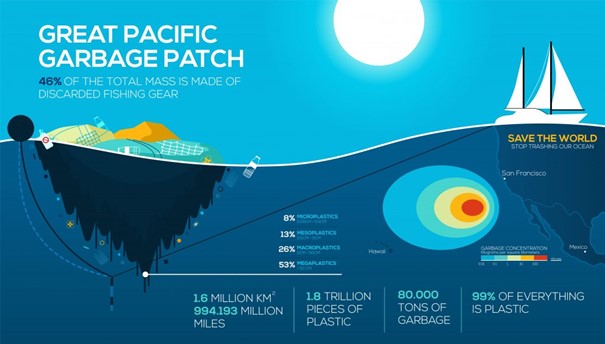The Great Pacific Garbage Patch
The Great Pacific Garbage Patch, also known as the plastic soup or the Pacific trash vortex, is a collection of human waste like plastic floating in the Pacific Ocean. The Great Pacific Garbage Patch spans waters from the West Coast of North America to Japan and covers an estimated surface area of 1.6 million square kilometers. For comparison, that is a floating dump twice the size of Texas and three times the size of France! If we don’t do anything about the GPGP, it will threaten the future of all marine biodiversity.

Where does the Great Pacific Garbage Patch come from?
The precise source of the Great Pacific Garbage Patch is unknown but a study published in the journal Science shows that plastic and other debris floats eastward out of countries in Asia. There are six primary sources: China, Indonesia, the Philippines, Vietnam, Sri Lanka and Thailand. Those countries combined are said to dump more plastic in the oceans than all other countries combined. China alone is responsible for 30% of all debris in the Great Pacific Garbage patch. When all this garbage starts floating and sticking together it looks like this:

How did the Great Pacific Garbage Patch come about?
The Great Pacific Garbage Patch originates from pollution on the shores of North Amerika and Asia. Just like any other high concentration of debris in our oceans, the GPGP had been created in recent years by ever-increasing amounts of marine pollution. This is mostly caused by single-use plastics that are easily thrown away when traveling. Waste floating in the sea is carried away by sea currents, and when this pollution meets in the middle of both shorelines, it often stays floating around in circles in the middle of the ocean while more debris is added to mix.
What can I do about the Great Pacific Garbage Patch?
You can start by living consciously without losing quality of life by avoiding single-use plastics. This is probably the quickest and easiest way to start minimizing your ecological footprint. Carry your natural grocery bag to the store, replace take-away cups with your own to-go cup, stop using products with microbeads and most importantly, start using natural of sustainable straws.

Cleaning up the Garbage Patches with The Ocean Cleanup
The Ocean Cleanup is a non-profit organization that has developed a revolutionary technology to get rid of the plastic currently circulating the oceans. With a passive cleanup method, The Ocean Cleanup has managed to use natural oceanic forces to rapidly and effectively clean up the plastic in the ocean. With a fleet of cleanup systems, The Ocean Cleanup aims to get rid of 50% of all plastic circulating in the Great Pacific Garbage Patch, in only 5 years.
To make sure new plastic doesn’t reach the oceans, The Ocean Cleanup also managed to develop the first scalable solution to intercept plastic in rivers before it reaches the oceans. By setting up interceptor systems at approximately 1,000 rivers around the world, they aim to halt 80% of plastic entering the oceans within 5 years from rollout. The interceptors are currently active in Rio Ozama, the Dominican Republic, the Klang river in Malaysia and the Cengkareng drain in Indonesia. Learn more about the Ocean Cleanup initiative and how to support this important cause here.
The cleanup system is simple and effective. Imagine a floating net with a huge skirt underneath it, capturing waste in the GPGP while lifting on the currents of the sea. Check out this video to see the cleanup system of The Ocean cleanup in action and visit the website to support this cause.
Watch video below for explanation of system 001 of The Ocean Cleanup.
Something to tell or share with us? Send us an email! We love to hear from you.
Follow us on Facebook: Bluemarcheonline
Follow us on Instagram: Bluemarcheonline

